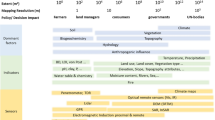Abstract
High soil phosphate concentrations are commonly related to intense past human activity although full understanding of this relationship requires further research. At present, practical constraints in the field, the need for extensive sampling and for rapid results, leads to the archaeologist frequently using crude but portable techniques of chemical analysis. The problems associated with the collection and interpretation of archaeological soil phosphate data are discussed. The use of Bayesian change-point analysis is proposed as a suitable statistical aid to the interpretation of such data.
Similar content being viewed by others
References
Ammerman, A.J. and Feldman, M.W. 1978. Replicated collection of site surfaces,American Antiquity 43(4), 734–740.
Arrhenius, O. 1938. Den Gotlandska Akerjordens fosfathalt,Sveriges GeologiskaUndersokning 32(2), 1–15.
Balaam, N.D. and Porter, H.M. 1982. The phosphate survey in the Shaugh Moor project: fourth report — environment, context and conclusion,Proceedings of the Prehistoric Society 48, 215–219.
Bintliff, J.L. and Snodgrass, A.M. 1985. The Cambridge/Bradford Boeotian Expedition: the first four years.Journal of Field Archaeology 12, 123–161.
Booth, N.B. and Smith, A.F.M. 1982. A Bayesian approach to retrospective identification of change-points,Journal of Econometrics 19(1), 7–22.
Buck, C.E., Cavanagh, W.G and Litton, CD. 1988. The spatial analysis of site phosphate data. InComputer Applications in Archaeology, 1988. British Archaeological Reports, British Series, Oxford.
Cavanagh, W.G., Hirst, S. and Litton, C.D. 1988. Soil phosphate, site boundaries and change-point analysis,Journal of Field Archaeology (in press).
Clark, A.J. 1977. Geophysical and chemical assessment of air photographic sites,Archaeological Journal 134, 187–193.
Conway, J.S. 1983. An investigation of soil phosphorus distribution within occupation deposits from a Romano-British hut group,Journal of Archaeological Science 10, 117–128.
Craddock, P.T., Gumey, D., Pryor, F. and Hughes, M.J. 1985. The application of phosphate analysis to the location and interpretation of archaeological sites,Archaeological Journal 142, 361–376.
Davis, J.C. 1986.Statistics and Data Analysis in Geology. Wiley, New York.
Edwards, K.J. 1983. Phosphate analysis of soils associated with the Old Kinord field and settlement system, Muir of Dinnet, Aberdeenshire,Proceedings of the Society of Antiquaries of Scotland 113, 620–627.
Frink, D.S. 1984. Artifact behaviour within the plow zone,Journal of Field Archaeology 11, 356–363.
Hinkley, D.V. 1971. Inference about the change-point from cumulative sum tests,Biometrika 58(3), 509–523.
Keeley, H.C.M., Hudson, G.E. and Evans, J. 1977. Trace element contents of human bones in various states of preservation: 1. The soil silhouette,Journal of Archaeological Science 4, 19–24.
McKerrell, H. and McCawley, J.C. 1971. Soil phosphorus levels at archaeologicalsites, Proceedings of the Society of Antiquaries of Scotland 104, 301–315.
Odell, G.H. and Cowan, F. 1987. Estimating tillage effects on artifact distributions,American Antiquity 52(3), 456–84.
Pettitt, A.N. 1979. A non-parametric approach to the change-point problem.Applied Statistics 28, 126–135.
Proudfoot, B. 1976. The analysis and interpretation of soil phosphorus in archaeological contexts. In: D.A. Davidson and M.L. Shackley (Eds.)Geoarchaeology, pp. 93–113. Duckworth, London.
Proudfoot, V.B. 1958. Problems of soil history,Journal of Soil Science 9, 186–190.
Shackley, M. 1981.Environmental Archaeology. George, Allen and Unwin, London.
Sieveking, G. de G., Longworth, I.H., Hughes, M.J., Clark, A.J. and Millett, A. 1973. A new survey of Grime's Graves — first report,Proceedings of the Prehistoric Society 39, 182–218.
Smith, A.F.M. 1975. A Bayesian approach to inference about a change-point in a sequence of random variables,Biometrika 62(2), 407–16.
Widgren, M. 1983. Settlement and farming systems in the early Iron Age. InStockholm Studies in Human Geography, 3. Almquist and Wiksell International, Stockholm.
Author information
Authors and Affiliations
Rights and permissions
About this article
Cite this article
Cavanagh, W.G., Buck, C.E. & Litton, C.D. The interpretation of noisy data from archaeological field survey: Phosphate analysis. Environ Geochem Health 10, 92–95 (1988). https://doi.org/10.1007/BF01758676
Received:
Accepted:
Issue Date:
DOI: https://doi.org/10.1007/BF01758676




